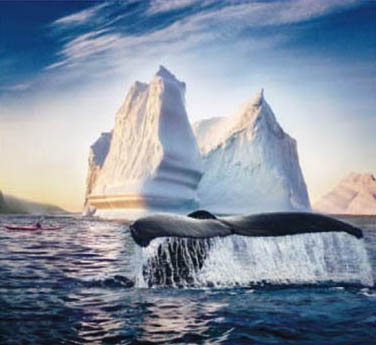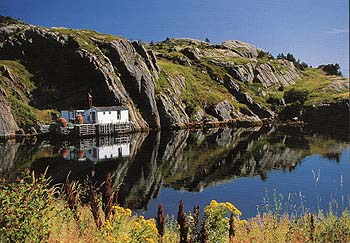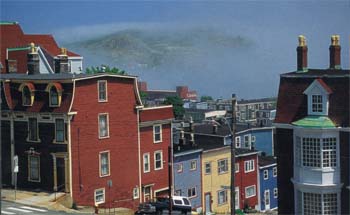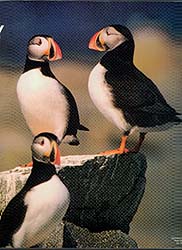Our Baron B55 was skimming low and the crew was looking for polar
bears, as we headed north over the broken rubble of
pack ice jammed up on a leeward shore against raw,
cold-looking vertical cliffs rising from the Labrador
Sea. Huge icebergs floated imperceptibly southeastward.
It was a beautiful day in northern Labrador.
The rugged Torngat Mountains, pierced
by ten mile fjords, rose high above our left wing
with a 4000MSL overcast just grazing their crests.
Glaciers flowed seaward from their massive ridges.
A low pressure system over Frobisher Bay - the next
airport 350 nautical miles further north - was beginning
to show its fringes, yet visibility of fifty miles
or better offered views of rugged country not often
seen by flatlanders.  The
crew had departed from Goose Bay two and a half hours
before. Curious, the pilot punched "nearest airport"
on his GPS navigator and the result was only one airport
-- Kuujjuag, 175 nautical miles to the west -- instead
of the accustomed ten airports that normally appear.
How in the world did a farmer from Virginia get in
this situation?
The
crew had departed from Goose Bay two and a half hours
before. Curious, the pilot punched "nearest airport"
on his GPS navigator and the result was only one airport
-- Kuujjuag, 175 nautical miles to the west -- instead
of the accustomed ten airports that normally appear.
How in the world did a farmer from Virginia get in
this situation?
After a three-year drought, the summer of 2002 was
dry and desert-like in Virginia and Fred Scott (ABS
LIFE 2219) got tired of looking at his farm -- where
he raises Hereford cattle and teaches people to drive
teams of huge Belgian draft horses -- drying up and
turning to dust. He thought a change of latitude would
improve his rapidly-descending spirits, so he arranged
for the cows and draft horse teams to be watered and
he headed for cooler climes. To the northern tip of
Labrador. Here's his story:
I have been all over northwestern Canada, and New
Brunswick, but had never been further northeast than
Nova Scotia
where I have walked and toured the wilderness in the Maritimes of Canada. Having always wanted
to see Newfoundland and Labrador, and having been
told by friends that the Isle de la Madelene and far
northern Labrador were also worth seeing, I left Virginia
on a late July morning in my B55 (IO-470) Baron. It's
an all-weather plane with modern GPS navigation systems
supplementing a complete dual vortac-based system
with flight director, weather radar, and deicing equipment.
We prepared the ship by pumping the struts as high
as was possible, so as to protect the props from gravel;
by adding 2" rubber collars clamped on the bottom
of each strut so as to have "get home" ability
if a strut collapsed up north.. We carried spare fuel
injectors, spare tires and tubes, a rifle and arctic
survival gear.... most of it left over from my sheep
hunting days in the Yukon.
The first leg was from this farm near Charlottesville,
Virginia to Bangor, Maine to clear customs outbound
with the survival rifle. On approach to Bangor, one
of our two vacuum pumps driving the flight instrument
gyros failed, so as I was doing the customs paperwork,
I asked the adjacent Telford Aviation FBO if they
could order a new one and have it FedExed in by 10AM
the next day. They pulled the top cowl off and got
the part number,  then
reported that they had the correct rebuilt spare sitting
on a shelf, so we installed the unit and off I went.
Total stop time: under one hour! Unbelievable! Now
we see why NASCAR is starting to hold races in New
Hampshire (Bangor will be next, obviously)
then
reported that they had the correct rebuilt spare sitting
on a shelf, so we installed the unit and off I went.
Total stop time: under one hour! Unbelievable! Now
we see why NASCAR is starting to hold races in New
Hampshire (Bangor will be next, obviously)
First night at Charlottetown, growing mainly potatoes, but with
a new automotive bridge from New Brunswick that will
change the island permanently.. To bed in a small
hotel and dinner in a quiet English pub, the Merchantman,
with scallops on rice. The
next morning I walked about five miles all around
the town, enjoying the architecture and the beautiful
Victoria Park.. At the end of my stroll, I noticed
the cruise ship ROTTERDAM at the dock, and figured
she was about to disgorge 5000 people into my quiet
space, so I called a taxi and headed for Isle de la
Madelene, a 100 mile long island in the Gulf of St.
Laurence.
Arriving around lunchtime, I took a low-level air
tour of this exquisite island. and tall
grassy covered cliffs that were being eroded by the
Gulf of St. Laurence; architecture similar to Nova
Scotia, mostly scattered farmhouses, but clearly the
farmers had discovered that hard top campers paid
more than sheep, as there were many groups of campers-on-pasture..
Lunch in the "Au Vieux Couvent" (the Old
School) restaurant ... a fabulous bouillabaisse (fish
soup). A
long and friendly chat with the three flight service
specialists in the tower (which is not a control tower,
though) at the airport, and another weather briefing
as there was a hurricane "Arthur" dissipating
just east of St. John's, Newfoundland, my destination
for the evening.
We filed IFR from Madelene across the Cabot Strait
to Stephenville on the southwest tip of the triangular
and, when twenty miles from the
southern coast, asked Gander Center for "direct
St. John's." No problem, and that route - I had
figured - would take me over and parallel to the southern
coast.. For an hour and a half or more, and well out
of Gander's radar coverage, I flew over the most desolate
and incredibly beautiful coastline, large fjords,
and tiny coastal villages served only by boat; over
green grass growing everywhere except on the barren
rocky hills and across thousands of small utterly
clear lakes among the rounded rocks.
Newfoundland is not high, so we flew at 4000MSL most
of the time. Because of the westerly flow around the
center of "Arthur," I was in and out of
the bands of rainshowers that are so typical of tropical
depressions, but had quite good looks at the coastline
below..  Only
three small roads descend north to south from the
main east-west Trans-Canada highway on the north coast...
so only three tiny south shore villages are accessible
to the Islanders by road.. The other occasional "outports"
on the south shore are served only by boat. Huge and
extraordinary ten-mile-long fjords offer shelter from
the sea. One single pleasure boat filled with adventurers
was sailing on a broad reach up one fjord and there
was no one within fifty miles of them. I wondered
what they were thinking; they must have been in awe,
as I was.
Only
three small roads descend north to south from the
main east-west Trans-Canada highway on the north coast...
so only three tiny south shore villages are accessible
to the Islanders by road.. The other occasional "outports"
on the south shore are served only by boat. Huge and
extraordinary ten-mile-long fjords offer shelter from
the sea. One single pleasure boat filled with adventurers
was sailing on a broad reach up one fjord and there
was no one within fifty miles of them. I wondered
what they were thinking; they must have been in awe,
as I was.
Landing in St. John's I met a USAF C-130 crew heading
from Florida into harm's way in Afghanistan and a
civilian C-130 freighter crew just in from Anchorage.
The USAF bird was an old special operations ship with
structures to hold two forks out in front, whereby
the plane drove through a balloon-supported rope,
catching it and jerking a person up off out of the
jungle.. I recall seeing that done once - in a James
Bond movie, perhaps - but the Air Force crew said
they don't do it any more! Just as well, and anyway,
that's a ride I do not care to take!
St. John's was home for two nights. Dinner on the
first night at NaGeira's
Restaurant, highly recommended by my Abba Bed
& Breakfast host. A sophisticated establishment
worthy of success in any major cosmopolitan city and
run by Lynn Pike, who claims to be descended from
a pirate captain's lady... There
I had a meal of mussels, poached calamari, and a salad..
Lovely Lynn joined me for a glass of wine, and asked
why I was in Newfoundland. I replied that I was just
a pilot, on holiday, looking around. She laughed,
said that her favorite plane was a Twin Otter, and
since she was not a pilot, I thought that slightly
unusual and asked how she arrived at that choice.
Her dad, she explained, owned Air Labrador, a local
airline, and was sitting at the next table with some
pilot friends. They all invited me to join them after
dinner for coffee.
There
I had a meal of mussels, poached calamari, and a salad..
Lovely Lynn joined me for a glass of wine, and asked
why I was in Newfoundland. I replied that I was just
a pilot, on holiday, looking around. She laughed,
said that her favorite plane was a Twin Otter, and
since she was not a pilot, I thought that slightly
unusual and asked how she arrived at that choice.
Her dad, she explained, owned Air Labrador, a local
airline, and was sitting at the next table with some
pilot friends. They all invited me to join them after
dinner for coffee.
Above NaGeira's in the bar -- Finnigan's Wake, named
after Lynn's Newfoundland dog -- I met Lynn's dad
Roger Pike, her mother and three American pilots:
Mark Rebholz, Blair Adamson, and Dennis Holbrooke.
These are the pilots and supporters who built a
bomber, which - flown by Alcock and Brown - was first
across the Atlantic Ocean in 1919 nonstop. Mark told
me that it is a pig of an airplane, requiring 80 pounds
of force to move the ailerons full deflection and
then achieving only nine degrees per second of response.
The pilot had better hope he never gets into moderate
turbulence (and has strong shoulder muscles!) Mark
Rebholz has made two previous long-distance VIMY flights
and is a senior United Airlines captain (from Aguila,
Arizona) . He flew the from Britain to Australia and
then again from England to South Africa and is now
preparing to fly it in Year 2003 from St. John's across
the Atlantic. They are bringing the VIMY to the Newport
News-Williamsburg airport, in Virginia, near where
I live, for the Aviation
World's Fair 2003 where from April 7-27, the will be prominently displayed in the historical
exhibit. I hope to see these nice folks again then.
Over coffee, Roger Pike spent some time
extolling the beauty of northern Labrador and encouraging
me both to go further north, perhaps as far as Frobisher
Bay, and also to check with his northern flight crews
about local operations in these very remote areas.
All very generous of him.
 To
Lynn Pike, who owns NaGeira's restaurant, where we
all met, and who joined me at my dinner for a while,
and Roger Pike and Mark Rebholz, please again accept
my thanks for a great evening. What a small world
we live in, as I have a friend, Mark Hegg - a proud
owner of a Colemill variant of the B55 and, like Mark
Rebholz, a United Airlines captain - who has made
thirty transatlantic crossings in light aircraft.
He was the first to encourage me to head for Baffin
Island and similar places.
To
Lynn Pike, who owns NaGeira's restaurant, where we
all met, and who joined me at my dinner for a while,
and Roger Pike and Mark Rebholz, please again accept
my thanks for a great evening. What a small world
we live in, as I have a friend, Mark Hegg - a proud
owner of a Colemill variant of the B55 and, like Mark
Rebholz, a United Airlines captain - who has made
thirty transatlantic crossings in light aircraft.
He was the first to encourage me to head for Baffin
Island and similar places.
 The
next day I rented a car and drove for six hours around
the "Irish Loop" on the Avalon peninsula
where it's easy to see - after a short boat ride -
seabird colonies of thousands of kittiwakes, puffins,
etc. Much further south, I drove through a herd of
Woodland Caribou (no woods, though, as they live in
the utterly stark barrens, eating moss). Shortly after,
near the Cape Race LORAN transmitter station, I watched
huge humpback whales playing in the surf of the Atlantic
Ocean less than 200 feet from where I was standing
on the cobbled beach of St. Vincent. Then home to
St. John's for dinner.
The
next day I rented a car and drove for six hours around
the "Irish Loop" on the Avalon peninsula
where it's easy to see - after a short boat ride -
seabird colonies of thousands of kittiwakes, puffins,
etc. Much further south, I drove through a herd of
Woodland Caribou (no woods, though, as they live in
the utterly stark barrens, eating moss). Shortly after,
near the Cape Race LORAN transmitter station, I watched
huge humpback whales playing in the surf of the Atlantic
Ocean less than 200 feet from where I was standing
on the cobbled beach of St. Vincent. Then home to
St. John's for dinner.
Next morning, I headed to the government offices and
bought some detailed charts of upper Labrador -- for
use in the unhappy event of our walking out of the
north country -- and then to the St. John's airport
where I met another C-130 crew - this one a well-armed
"Spooky" or "PUFF" gunship - returning
from Afghanistan. I told them I'd not like to make
them mad at me, and expressed concern for them about
the recent wedding party incident in Afghanistan.
They suggested that there was more to hear than we
had heard so far. (Upon returning to Virginia a week
later I discovered that their story had come out:
apparently the gunship had video of itself being fired
upon, before it returned fire into the village).
That morning - the second day after I met the VIMY
crew - the little Baron flew along the northern coast
of Newfoundland - again facing the Atlantic - and
back to the west coast to have a look at the Gros
Morne national park from the air. Rivaling Glacier
Park in the states for raw beauty this .. From the air,
just above, there appeared to be no auto-accessible
overlooks or even walking trails, so I'm guessing
it is a park much under-used by the public. I shall
return with my walking friends and we will spend a
week or so there.
Then, turning north up the western coast of Newfoundland
and across the Straits of Belle Isle to Labrador,
followed by a low level flight along the curved lower
southeastern coast of Labrador for several hours over
bare rocky slopes pierced by lakes, ponds, and inlets
from the Labrador Sea. Ultimately we arrived at a
large inlet heading west from Groswater Bay and flew
across the length of Lake Melville into Goose Bay,
adjacent to which is a smaller body of water called
Gosling Bay... but, of course!. This flight brought
into view the huge icebergs floating southeasterly
down the Labrador Sea. The coastal terrain seen from
above is scalped rock, with very little soil, as the
glaciers had removed it eons ago.. Thousands of small
and large lakes are interspersed with grassy spots
or yellow caribou moss. Further inland, small trees
struggle to live, and still further inland, large
forests thrive.
Goose Bay is located about 150 miles inland and is
mostly fog-free, thereby making  it
an ideal stopover for the W.W.II crews who needed
fuel. I was greeted with warmth by Beverly Curlew
- one of the best of all aviation Customer Service
Representatives I have ever met - at Woodward Aviation.
All I needed was a place to sleep, so I checked into
one of the hotels there (they are all about the same).
It was a metal building quickly thrown up, but excellent
for protecting sleeping guests from the MINUS 40 degree
winter temperatures. (I will be long gone by then!!).
The room was perfectly comfortable and clean.
it
an ideal stopover for the W.W.II crews who needed
fuel. I was greeted with warmth by Beverly Curlew
- one of the best of all aviation Customer Service
Representatives I have ever met - at Woodward Aviation.
All I needed was a place to sleep, so I checked into
one of the hotels there (they are all about the same).
It was a metal building quickly thrown up, but excellent
for protecting sleeping guests from the MINUS 40 degree
winter temperatures. (I will be long gone by then!!).
The room was perfectly comfortable and clean.
Dinner that evening with three charming Frenchmen
who I had met at the airport. As I was working Goose
Approach, I had heard two French-accented pilots approaching
as well. After landing, I pulled up next to two new
TBM-700's with US markings which had just arrived
from France. They were flown by two EADS Socata test
plots: Christian Briand and Dominique Deschamps..
Their chief avionics engineer was along for the ride,
all headed to Florida to deliver these beauties to
two lucky new owners, and then on to Oshkosh, to attend
AirVenture 2002 which was a few days off.
The following day, I took Roger Pike's (owner of Air
Labrador) advice, and dropped by the float dock to
meet Mike Byrne, a legend in the north country and
a senior Air Labrador floatplane captain (40,000-50,000
flying hours) and get some local advice before heading
further north. I have flown quite a bit in the north
country, and mostly on floats, but a Baron in the
north is unusual, especially when many of the bail-out
strips are 2000 feet long and gravel. The farther
north one goes, the less is the likelihood of finding
readily available 100LL fuel. So, the trip can be
done, but the strips are a long way from fuel, the
short strips have none, and it's tough to do when
carrying full load of fuel, so I was looking for all
the advice I could beg, borrow, or steal.
Mike Byrne was was heading out in his Twin Otter on
straight floats to take a few salmon fishermen to
camp on the Eagle River, one of the most productive
salmon rivers in Labrador. We had talked for some
time while his Otter was being loaded, and he, knowing
by then that I am float rated, said "get in"
(the back, which was fine) so I had a nice flight
to Eagle River, met some interesting fishermen and
ladies, and after we docked at the lodge 150 miles
from Goose Bay, Mike and I walked up to this wonderful
salmon lodge and
we then returned to the Goose Bay float dock.
Incidentally, a friend and I once owned a Caravan
on amphibious floats, which is OK for private use,
but is not a very good moneymaking floatplane for
use in airline service, for a number of reasons, so
I'm reasonably familiar with turbine float operations.
At Eagle River I saw something impressive: Mike landed
the turbine powered Twin Otter upriver, which is normal,
then pivoted 180 degrees and docked the plane at the
base of a riffle, with the tail upstream and with
the river water running along the dockside at about
five to seven knots, by BACKING UP the Otter with
asymmetrical reverse thrust, and the water rudders,
also operating backwards. He had no choice, because
the Otter, like my Caravan, only has one large cargo
door on the left aft side. I had known it could be
done but had never tried it in running water or ever
seen it done before. It was an honor get to know and
to be flown by someone who made it look so very easy;
which it most assuredly is not. I asked how he did
it in the Caravan and he replied that they did not..
The Caravan was unloaded into boats on the river side.
Note: the images
on this page are copyrighted by
and being used with the kind permission of
Harnum Scenics (709) 745-0812 and M&B
Postcards (709) 745-1908
Some images are from the Newfoundland & Labrador
tourist bureau.
We thank them all.
After unloading, reloading the Otter
and flying the previous week's fishermen back to Goose
Bay, it was then 10AM and Mike was doing his best
to figure out how to go with me "Up North"
(where I was headed, but well north of his normal
routes) as he loves it up there and repeatedly said
how fantastic our flight would be. But he was scheduled
to fly all day, so he hooked me up with his young
dispatcher Mandy Kean, who - by the time you read
this - is also flying the line in her Air Labrador
Twin Otter. Mandy is a commercial, multi-engine and
instrument pilot, with really good flying and cockpit
communication skills and Mike as ked me to show her
the north country -
which she had never seen - at the same time she was
telling me about the strips to which she dispatches
aircraft daily.
CLICK
HERE TO SEE THE FAR NORTH COUNTRY and
Canadian
Flight Information
or Click here for Travel videos (QuickTime movies):
Many of these images were taken from the aircraft.






